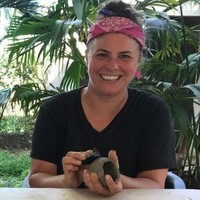- PhDedit
Research Interests:
We use thin section petrography and SEM-EDS to analyze fabrics, slips, and paints on ceramics from the Classic Period Maya center of Uxbenká located in the Toledo District of southern Belize. Pottery produced in southern Belize differs... more
We use thin section petrography and SEM-EDS to analyze fabrics, slips, and paints on ceramics from the Classic Period Maya center of Uxbenká located in the Toledo District of southern Belize. Pottery produced in southern Belize differs from other regions of the Maya lowlands due to the underlying bedrock composed of interbedded calcareous sandstones and siltstone rather than limestone. Our analyses indicate that Late to Terminal Classic (c. CE 600-900) pottery at Uxbenká was produced in five primary fabric groups using locally available raw materials. The composition of red slips is indistinguishable from the associated ceramic fabrics. White and orange slips on polychrome vessels are composed of very fine calcareous sandstone rather than micritic limestone used in other regions. Pottery production changed over time from the Early Classic (c. AD 250/300-600) to the Late Classic Period when crystalline calcite temper was used less frequently. This is the first study to analyze pottery from southern Belize using petrography and SEM-EDS. These data provide information on pottery production practice at Uxbenká where potters did not have access to limestone derived raw materials and will aid in evaluating social and economic interactions between southern Belize and other regions of the Maya lowlands.
Research Interests:
Non-elite populations in the Maya lowlands interacted with one another across spatial boundaries. However, documenting this interaction at the local level is difficult because households are often constructed of similar materials and... more
Non-elite populations in the Maya lowlands interacted with one another across spatial boundaries. However, documenting this interaction at the local level is difficult because households are often constructed of similar materials and contain a similar suite of locally produced artifacts. This paper focuses on stylistic and technological analysis of pottery from Late to Terminal Classic (600-900 CE) Baking Pot in the Belize River Valley to reconstruct interaction networks among non-elite potters within the communities of practice theoretical framework. Our data suggests that most potters conceived of and engaged with the landscape in a similar fashion and created technologically and morphologically similar ceramic vessels. While shared technological traditions certainly suggests some form of information exchange among potters, there is enough variability in paste recipe to argue against a single community of practice. Potters living across the region were part of a constellation of practice. They are linked by practice through a shared taskscape in which habitation, farming, and resource acquisition occurred in similar locations.
Research Interests:
ISBN 978-1-60732-655-7 (hardcover) ISBN 978-1-60732-656-4 (digital)
Full Ceramic Fabric Descriptions with Micrographs
Research Interests:
Full Ceramic Fabric Descriptions with Micrographs
